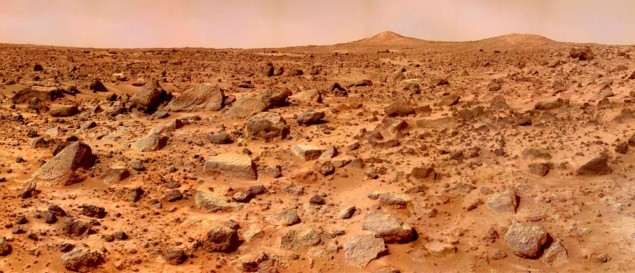
The sands of Mars are a conundrum for physicists. Both dunes and ripples of sand appear to move around on the surface, and the stuff has fallen onto the deck of NASA’s Spirit Martian rover. Yet measurements of the Martian wind suggest that it rarely gets strong enough to lift even a single grain.
Now a researcher in the US believes to have solved this apparent contradiction. “While it is very difficult for the wind to lift sand grains, once the wind does become strong enough to start blowing sand on Mars, the sand will keep bouncing, even when the wind speed drops by up to a factor of 10,” explains Jasper Kok from the University of Michigan in Ann Arbor.
It’s a lot like riding a bike Jasper Kok, University of Michigan
Kok has used a numerical model to describe accurately how sand grains move or “saltate” over the surface and then splash into the ground. He has found that the red planet’s lower gravity, coupled with its lower air resistance, allows a “hysteresis” effect to occur whereby sand grains require strong wind speeds only to start them moving. Once the grains are in the air, any remaining wind can accelerate them further until they finally slam into the ground, ejecting more grains into the atmosphere. “It’s a lot like riding a bike,” says Kok. “It costs a lot of exertion to get the bike going, but once you’re going it’s much easier to keep going.”
The hysteresis effect is so pronounced that it can explain why saltation seems to be commonplace. Kok’s model shows that while Martian sand grains need hurricane-strength wind speeds of 150 km/h to start moving, they will keep bouncing over the surface at wind speeds of just 15 km/hour.
Everyday Martian winds
“We all knew that, in order for saltation to start, wind velocities must reach peaks well above the average,” says Eric Parteli, an expert in saltation at the Federal University of Ceará in Brazil. “However, Kok shows us a very important and novel insight, namely that once saltation is initiated, it can last under typical, average, ‘everyday’ Martian wind velocities…Kok’s findings will change drastically our way of viewing aeolian processes on Mars’s surface.”
Kok told physicsworld.com that the next question is how saltation could be involved in Martian dust storms. On Earth, dust storms happen when wind blows sand into the ground, kicking up puffs of dust. However, it is not clear whether the same process happens on Mars. “What is generating the dust in dust storms?” asks Kok. “Is it saltation or something else? My finding that the sand can be blowing at much lower wind speeds on Mars makes it more likely that saltation plays an important role in Martian dust storms, but more research is needed.”
The research was published in Phys. Rev. Lett. 104 074502.



